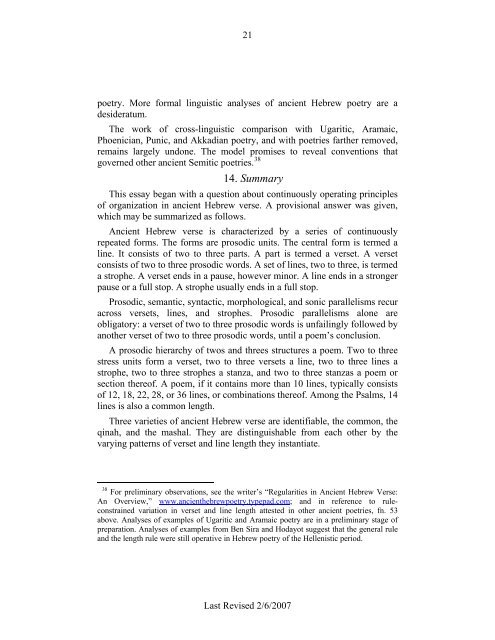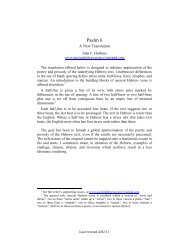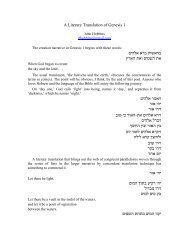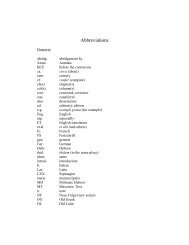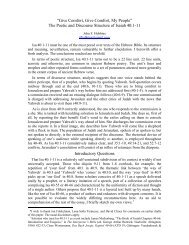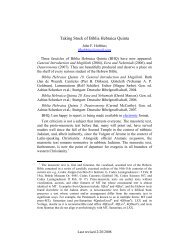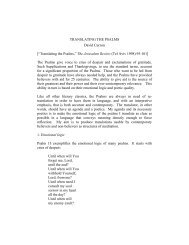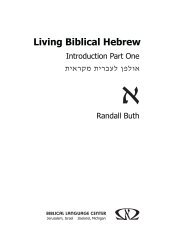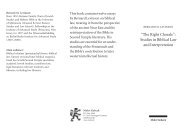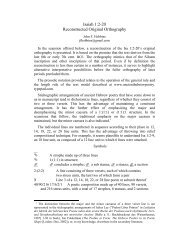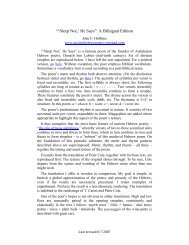Hebrew Poetry - Ancient Hebrew Poetry - Typepad
Hebrew Poetry - Ancient Hebrew Poetry - Typepad
Hebrew Poetry - Ancient Hebrew Poetry - Typepad
Create successful ePaper yourself
Turn your PDF publications into a flip-book with our unique Google optimized e-Paper software.
21poetry. More formal linguistic analyses of ancient <strong>Hebrew</strong> poetry are adesideratum.The work of cross-linguistic comparison with Ugaritic, Aramaic,Phoenician, Punic, and Akkadian poetry, and with poetries farther removed,remains largely undone. The model promises to reveal conventions thatgoverned other ancient Semitic poetries. 3814. SummaryThis essay began with a question about continuously operating principlesof organization in ancient <strong>Hebrew</strong> verse. A provisional answer was given,which may be summarized as follows.<strong>Ancient</strong> <strong>Hebrew</strong> verse is characterized by a series of continuouslyrepeated forms. The forms are prosodic units. The central form is termed aline. It consists of two to three parts. A part is termed a verset. A versetconsists of two to three prosodic words. A set of lines, two to three, is termeda strophe. A verset ends in a pause, however minor. A line ends in a strongerpause or a full stop. A strophe usually ends in a full stop.Prosodic, semantic, syntactic, morphological, and sonic parallelisms recuracross versets, lines, and strophes. Prosodic parallelisms alone areobligatory: a verset of two to three prosodic words is unfailingly followed byanother verset of two to three prosodic words, until a poem’s conclusion.A prosodic hierarchy of twos and threes structures a poem. Two to threestress units form a verset, two to three versets a line, two to three lines astrophe, two to three strophes a stanza, and two to three stanzas a poem orsection thereof. A poem, if it contains more than 10 lines, typically consistsof 12, 18, 22, 28, or 36 lines, or combinations thereof. Among the Psalms, 14lines is also a common length.Three varieties of ancient <strong>Hebrew</strong> verse are identifiable, the common, theqinah, and the mashal. They are distinguishable from each other by thevarying patterns of verset and line length they instantiate.38 For preliminary observations, see the writer’s “Regularities in <strong>Ancient</strong> <strong>Hebrew</strong> Verse:An Overview,” www.ancienthebrewpoetry.typepad.com; and in reference to ruleconstrainedvariation in verset and line length attested in other ancient poetries, fn. 53above. Analyses of examples of Ugaritic and Aramaic poetry are in a preliminary stage ofpreparation. Analyses of examples from Ben Sira and Hodayot suggest that the general ruleand the length rule were still operative in <strong>Hebrew</strong> poetry of the Hellenistic period.Last Revised 2/6/2007


